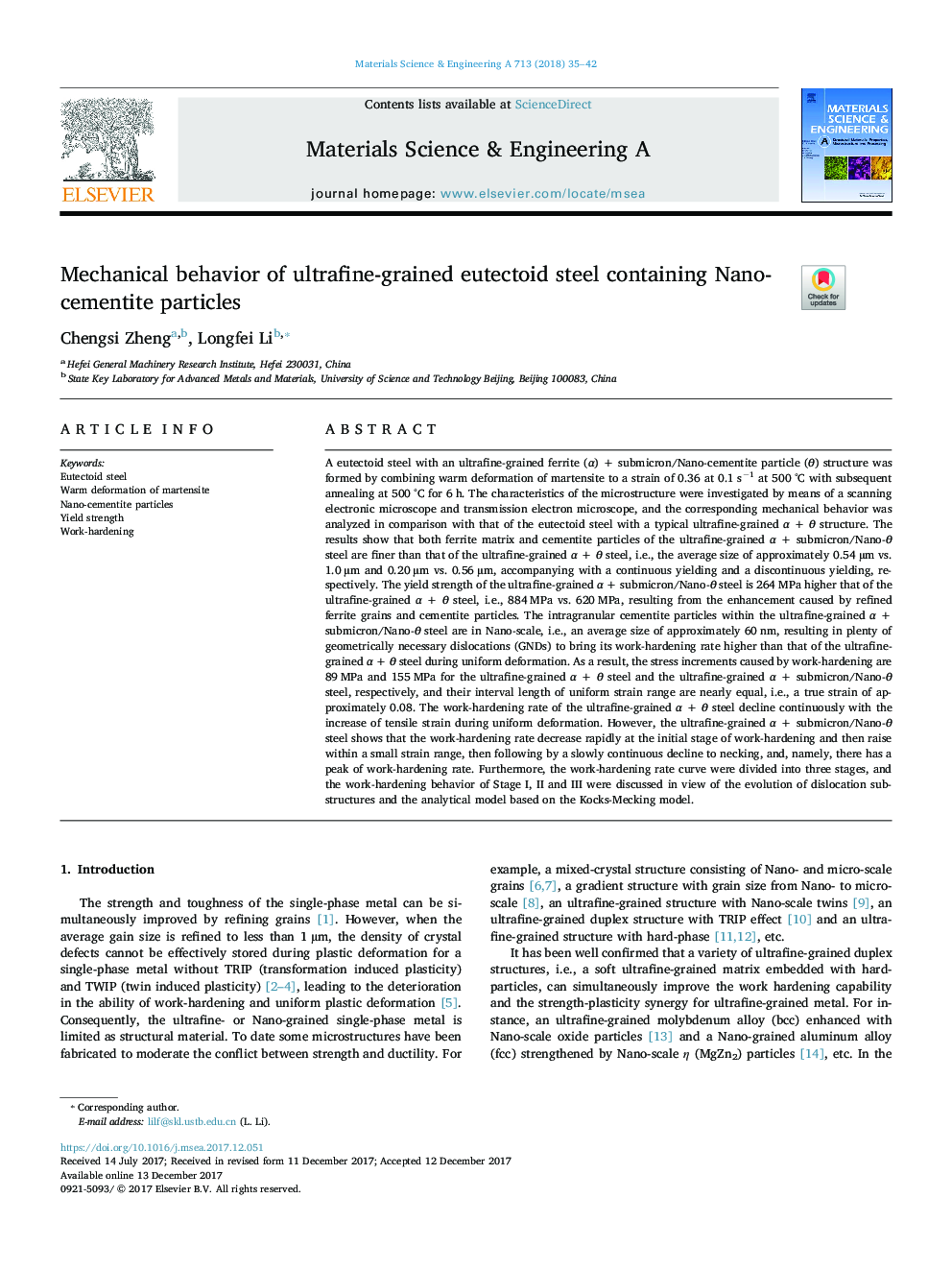| کد مقاله | کد نشریه | سال انتشار | مقاله انگلیسی | نسخه تمام متن |
|---|---|---|---|---|
| 7973701 | 1514630 | 2018 | 8 صفحه PDF | دانلود رایگان |
عنوان انگلیسی مقاله ISI
Mechanical behavior of ultrafine-grained eutectoid steel containing Nano-cementite particles
ترجمه فارسی عنوان
رفتار مکانیکی فولاد ائتکتوئید فوق پر از دانه حاوی ذرات نانو سیمانتتی
دانلود مقاله + سفارش ترجمه
دانلود مقاله ISI انگلیسی
رایگان برای ایرانیان
کلمات کلیدی
موضوعات مرتبط
مهندسی و علوم پایه
مهندسی مواد
دانش مواد (عمومی)
چکیده انگلیسی
A eutectoid steel with an ultrafine-grained ferrite (α) + submicron/Nano-cementite particle (θ) structure was formed by combining warm deformation of martensite to a strain of 0.36 at 0.1 sâ1 at 500 °C with subsequent annealing at 500 °C for 6 h. The characteristics of the microstructure were investigated by means of a scanning electronic microscope and transmission electron microscope, and the corresponding mechanical behavior was analyzed in comparison with that of the eutectoid steel with a typical ultrafine-grained α + θ structure. The results show that both ferrite matrix and cementite particles of the ultrafine-grained α + submicron/Nano-θ steel are finer than that of the ultrafine-grained α + θ steel, i.e., the average size of approximately 0.54 µm vs. 1.0 µm and 0.20 µm vs. 0.56 µm, accompanying with a continuous yielding and a discontinuous yielding, respectively. The yield strength of the ultrafine-grained α + submicron/Nano-θ steel is 264 MPa higher that of the ultrafine-grained α + θ steel, i.e., 884 MPa vs. 620 MPa, resulting from the enhancement caused by refined ferrite grains and cementite particles. The intragranular cementite particles within the ultrafine-grained α + submicron/Nano-θ steel are in Nano-scale, i.e., an average size of approximately 60 nm, resulting in plenty of geometrically necessary dislocations (GNDs) to bring its work-hardening rate higher than that of the ultrafine-grained α + θ steel during uniform deformation. As a result, the stress increments caused by work-hardening are 89 MPa and 155 MPa for the ultrafine-grained α + θ steel and the ultrafine-grained α + submicron/Nano-θ steel, respectively, and their interval length of uniform strain range are nearly equal, i.e., a true strain of approximately 0.08. The work-hardening rate of the ultrafine-grained α + θ steel decline continuously with the increase of tensile strain during uniform deformation. However, the ultrafine-grained α + submicron/Nano-θ steel shows that the work-hardening rate decrease rapidly at the initial stage of work-hardening and then raise within a small strain range, then following by a slowly continuous decline to necking, and, namely, there has a peak of work-hardening rate. Furthermore, the work-hardening rate curve were divided into three stages, and the work-hardening behavior of Stage I, II and III were discussed in view of the evolution of dislocation substructures and the analytical model based on the Kocks-Mecking model.
ناشر
Database: Elsevier - ScienceDirect (ساینس دایرکت)
Journal: Materials Science and Engineering: A - Volume 713, 24 January 2018, Pages 35-42
Journal: Materials Science and Engineering: A - Volume 713, 24 January 2018, Pages 35-42
نویسندگان
Chengsi Zheng, Longfei Li,
